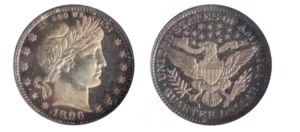The 1896 Barber Quarter Proof: A Tangible Connection to the Gilded Age
Posted on — Leave a commentThe Barber Quarter is a perennial favorite among collectors for its historical significance and the exciting challenge that comes with trying to assembling a complete set, including coins from all mint facilities.
In their era, Barber Quarters primarily went immediately into circulation and stayed there. They were heavily used and today survivors in high grades are scarce. In 1896, a mere 762 Barber proofs were minted. Today, high-quality 1896 Barber proof quarters are hard to come by. There’s only an estimated 250 survivors in grades 65 or better.
To hold a 1896 Barber Quarter in your hand is a direct connection to one of the most economically vibrant periods in our nation’s history. This coin was minted towards the end of the Gilded Age.
The rapid growth of heavy industry, like factories, railroads, and coal mining, drove economic growth forward at a furious pace in these years. The Gilded Age era featured storied wealthy industrialists and financiers like John D. Rockefeller, Andrew Carnegie, J.P. Morgan, and Cornelius Vanderbilt, who are well-remembered today. Many of their Gilded Age fortunes were turned to good use through philanthropy, and they continue to impact people’s lives today through universities, hospitals, museums, and libraries.
Barber quarters were minted from 1892 to 1916. The striking coin is named after its designer, United States Bureau of the Mint Chief Engraver Charles E. Barber. The Barber quarter is part of a series of coins, which today collectors refer to as the “Barber coinage.” This includes a dime, quarter and half dollar.
Today, collectors strive to own a collection of Barber quarters minted at all the different U.S. Mint facilities, including Philadelphia (no mint mark), New Orleans (O mint mark), San Francisco (S mint mark), and Denver (D mint mark).
The Barber quarter was introduced as part of a modernization effort of our nation’s coinage, and it replaced the Seated Liberty quarter, which had been in circulation since 1838. The Barber quarter has earned a revered place in the numismatic world as it represents the changing coinage during the late 19th century.
Minted with 90% silver and 10% copper, the obverse features a bust of Liberty facing right. She wears a Phrygian cap, which is a symbol of freedom, and is surrounded by the words “IN GOD WE TRUST.” The date is located below the bust of Liberty. The reverse highlights a memorable heraldic eagle with outstretched wings. The eagle holds an olive branch and arrows in its talons, symbolizing peace and strength.
This coin was minted during an extraordinary period of American history—the Gilded Age. Other memorable events in 1896: Utah was admitted as the 45th state to the United States of America, in May 1896, a group of 12 industrial stocks was chosen to form the Dow Jones Industrial Average, and in November 1896, Republican William McKinley won the U.S. presidential election, defeating William Jennings Brian. Take a look at the artistry of the 1896 Barber Quarter Proof here and imagine holding it in your hand as a way to connect to this historic time in America.








